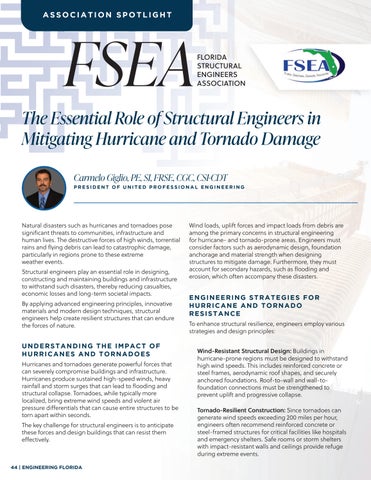ASSOCIATION SPOTLIGHT
FSEA
FLORIDA STRUCTURAL ENGINEERS ASSOCIATION
The Essential Role of Structural Engineers in Mitigating Hurricane and Tornado Damage Carmelo Giglio, PE, SI, FRSE, CGC, CSI-CDT PRESIDENT OF UNITED PROFESSIONAL ENGINEERING
Natural disasters such as hurricanes and tornadoes pose significant threats to communities, infrastructure and human lives. The destructive forces of high winds, torrential rains and flying debris can lead to catastrophic damage, particularly in regions prone to these extreme weather events. Structural engineers play an essential role in designing, constructing and maintaining buildings and infrastructure to withstand such disasters, thereby reducing casualties, economic losses and long-term societal impacts. By applying advanced engineering principles, innovative materials and modern design techniques, structural engineers help create resilient structures that can endure the forces of nature.
UNDERSTANDING THE IMPACT OF HURRICANES AND TORNADOES Hurricanes and tornadoes generate powerful forces that can severely compromise buildings and infrastructure. Hurricanes produce sustained high-speed winds, heavy rainfall and storm surges that can lead to flooding and structural collapse. Tornadoes, while typically more localized, bring extreme wind speeds and violent air pressure differentials that can cause entire structures to be torn apart within seconds. The key challenge for structural engineers is to anticipate these forces and design buildings that can resist them effectively.
44 | ENGINEERING FLORIDA
Wind loads, uplift forces and impact loads from debris are among the primary concerns in structural engineering for hurricane- and tornado-prone areas. Engineers must consider factors such as aerodynamic design, foundation anchorage and material strength when designing structures to mitigate damage. Furthermore, they must account for secondary hazards, such as flooding and erosion, which often accompany these disasters.
ENGINEERING STRATEGIES FOR HURRICANE AND TORNADO RESISTANCE To enhance structural resilience, engineers employ various strategies and design principles: Wind-Resistant Structural Design: Buildings in hurricane-prone regions must be designed to withstand high wind speeds. This includes reinforced concrete or steel frames, aerodynamic roof shapes, and securely anchored foundations. Roof-to-wall and wall-tofoundation connections must be strengthened to prevent uplift and progressive collapse. Tornado-Resilient Construction: Since tornadoes can generate wind speeds exceeding 200 miles per hour, engineers often recommend reinforced concrete or steel-framed structures for critical facilities like hospitals and emergency shelters. Safe rooms or storm shelters with impact-resistant walls and ceilings provide refuge during extreme events.













